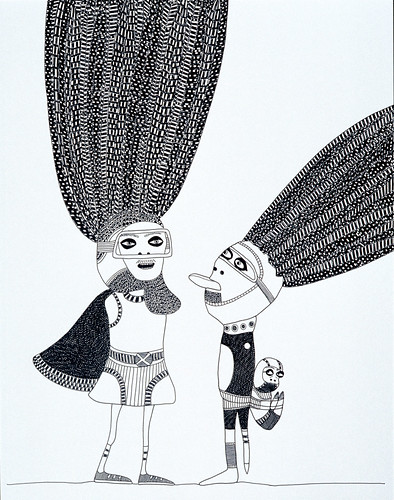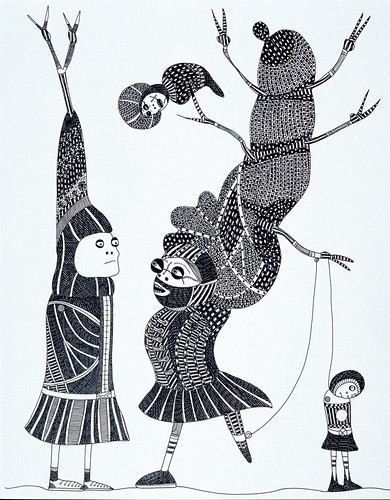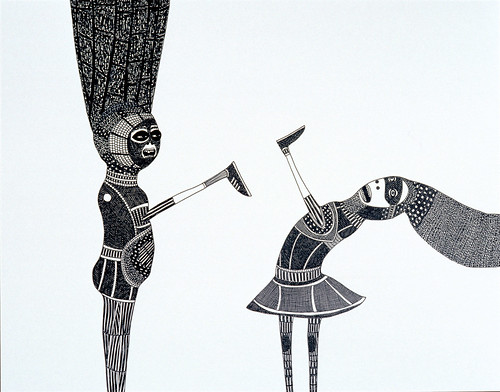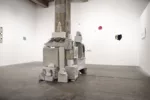This week’s Weekly has my review of Laylah Ali‘s solo exhibit at PAFA‘s Morris Gallery. Below is the copy with more photos. Here’s Libby’s post. And more photos at flickr.
Pretty in Ink
Laylah Ali’s deformed drawings are full of drama.

Laylah Ali (b. 1968)
Untitled, 2005 (from the Typology Series)
Ink on paper, 14 x 11 inches
Courtesy of the artist and 303 Gallery, New York
“Drawings From the Typology Series,” Laylah Ali’s marvelous and mocking salute to typological folly at the Pennsylvania Academy of the Fine Arts’ Morris Gallery, is a reminder of the danger of judging a book by its cover and people by their physical characteristics. But the exhibit’s also a hyperbolic and grandiose show with characters dressed in outlandish regalia (chainmail, kilts, breast plates) with sculpted hair that makes Princess Amidala look like a shorn Britney Spears.
In one ink drawing after another Ali serves up people who are deformed. Many have no arms, or legs jutting out where arms should be. Their reduced facial characteristics and uniclothing render them gender neutral and racially ambiguous—everyman and everywoman—but decked out in clothing so cool they’d be at home on a Paris fashion runway.
The “Typology” drawings have been several years in the making. Ali’s switch from the rich gouache color and minimal detail of her famous Greenheads painting to these obsessively patterned ink drawings is a big leap, but one that continues the artist’s exploration of human interaction and emotional and physical violence. Where Greenheads used a basketball metaphor (some characters have basketball-like heads and wear sneakers and athletic socks), “Typologies” is in the land of religious icons and outsider and aboriginal art.

What remains the same is Ali’s compositional bravura, her exquisite negative spaces, and her ability to imply drama without really giving you a story. Ali’s characters are mostly rigid and static—as if in a choreographed tableau. Grouped very close together, they almost never touch. Even in works in which kissing is implied, the mouths are open and somebody’s tongue is in somebody else’s mouth, but the two still don’t seem to be close, and they sure aren’t loving it. Interaction is implied by the tension in the bodies and faces—and the tension in the crisp, clean, ambiguously pure space between.
Ali is not about the narrative. The blood, battles and smackdowns implied by her angry cast of characters take place offstage, as in Greek tragedy.

Laylah Ali (b. 1968)
Untitled, 2005 (from the Typology Series)
Ink on paper, 14 x 11 inches
Courtesy of the artist and 303 Gallery, New York
Hyperbole, as used in this show, helps create the distance we need to connect with the deeper truth. Dickens and Balzac did this in their writing. Cartoonists have long plied the extremes of physicality to depict type and truth. In our day artists like Ali and Kara Walker use stereotype to blast new meaning into the discussion.
Laylah Ali: “Drawings From the Typology Series”
Artist lecture: Thurs., April 5, 11:30am. Free. Pennsylvania Academy of the Fine Arts, 128 N. Broad St. 215.972.7600.









